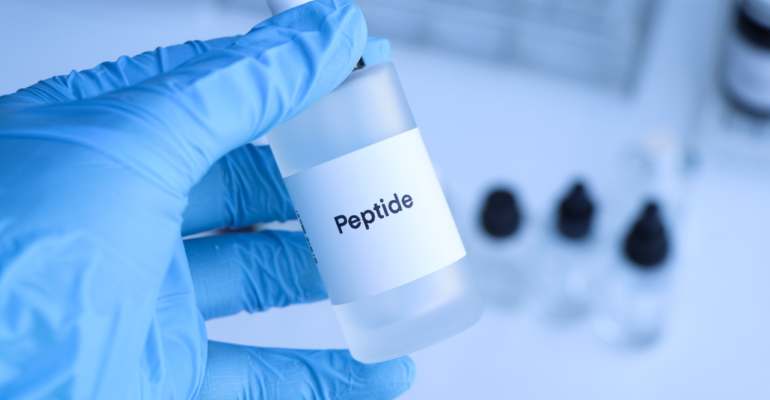Peptides in Skincare: A Complete Dermatologist Guide
April 21, 2025 2025-04-22 10:19Peptides in Skincare: A Complete Dermatologist Guide
As an Amazon associate, Dermatocare earns from valid purchase made by clicking on the affiliate links in this blog.

Peptides in Skincare: A Complete Dermatologist Guide
Peptides have emerged as a cornerstone ingredient in advanced skincare, lauded for their role in skin regeneration, anti-aging, and barrier support. While widely used in anti-aging formulations, peptides offer much broader benefits across various skin concerns. This comprehensive guide explores their science, benefits, types, appropriate age-wise use, application methods, potential side effects, and contraindications.
What Are Peptides?
Peptides are short chains of amino acids—the fundamental building blocks of proteins such as collagen, elastin, and keratin. In dermatology, peptides are used to mimic natural signaling molecules, stimulate cellular communication, and repair the skin matrix.
When applied topically, specific peptides can help promote collagen synthesis, inhibit muscle contraction (mimicking Botox-like effects), improve hydration, and strengthen the skin barrier.
Benefits of Peptides in Skincare
Peptides offer a wide array of dermatological and cosmetic advantages:
- Stimulates Collagen Production: Helps improve skin firmness, reduce fine lines and wrinkles.
- Improves Skin Elasticity: Promotes elastin synthesis for more resilient skin.
- Repairs Skin Barrier: Enhances the production of ceramides and lipids.
- Reduces Inflammation: Some peptides possess anti-inflammatory properties beneficial for sensitive or rosacea-prone skin.
- Brightens Skin: Certain peptides reduce melanin synthesis, aiding in pigmentation control.
- Boosts Hydration: Supports skin’s natural moisturizing factors (NMFs).
Different Types of Peptides in Skincare
| Peptide Type | Function | Common Examples |
|---|---|---|
| Signal Peptides | Stimulate collagen, elastin, and other structural proteins | Palmitoyl pentapeptide (Matrixyl), Copper peptides |
| Carrier Peptides | Deliver trace elements (e.g., copper) to skin for healing and enzyme activation | GHK-Cu (Copper Tripeptide-1) |
| Enzyme Inhibitor Peptides | Reduce enzyme activity that breaks down collagen (MMPs) | Soy peptides, silk peptides |
| Neurotransmitter-Inhibiting Peptides | Inhibit facial muscle contraction, mimic Botox-like effects | Argireline (Acetyl Hexapeptide-8) |
| Antimicrobial Peptides | Offer protection against harmful microorganisms | Defensins, cathelicidins |
| Brightening Peptides | Inhibit melanin synthesis | Oligopeptide-68, undecylenoyl phenylalanine |
Which Peptide Type is Best Age-Wise?
| Age Group | Recommended Peptides | Purpose |
|---|---|---|
| 20s | Moisturizing and antioxidant peptides (e.g., silk peptides) | Preventive care, barrier support |
| 30s | Signal peptides (e.g., Matrixyl) | Early collagen stimulation and fine line prevention |
| 40s–50s | Copper peptides, neuropeptides (e.g., Argireline) | Firmness, deep wrinkle reduction, even tone |
| 50s+ | Combination therapies with multiple peptide types | Multi-layered repair and regeneration |
How to Use Peptides in Skincare
- Form: Found in serums, moisturizers, eye creams, and face masks.
- When to Apply: After cleansing and toning, and before occlusive moisturizers or oils.
- Frequency: Can be used twice daily; peptides are stable and compatible with most skincare ingredients.
- Complementary Actives:
- Combine with hyaluronic acid for hydration.
- Pair with niacinamide for enhanced barrier repair.
- Peptides and retinoids can be used together, especially in formulations designed to enhance anti-aging effects. Such combination products are often synergistic and offer more comprehensive rejuvenation results.
- Avoid layering with low pH acids (AHAs/BHAs) unless the product is formulated for such use, to maintain peptide stability.
Side Effects of Peptides
Peptides are well-tolerated by most skin types, including sensitive skin. However, potential concerns include:
- Mild irritation if combined with harsh exfoliants or in unstable formulations.
- Allergic reaction to specific peptide complexes, though rare.
- Breakouts if mixed with heavy, comedogenic formulations in oily or acne-prone skin.
Who Should Avoid Peptides?
Peptides are safe for most people, but caution is advised in:
- Individuals with active skin infections or open wounds (in case of copper peptides).
- Those with a history of allergic dermatitis to complex skincare products should patch test.
- Avoid combining with low pH products (like strong AHAs/BHAs) unless directed by a dermatologist or specified by the product.
Conclusion
Peptides are a scientifically backed, multifunctional ingredient in dermatological skincare. They offer targeted benefits ranging from collagen stimulation to anti-inflammatory and skin-brightening effects. Their low risk of irritation makes them suitable for daily use across all age groups and skin types.
Incorporating peptides early can prevent signs of aging, while in mature skin, they can be powerful tools for visible rejuvenation. Selecting the right peptide formulation—combined with a well-rounded skincare routine—can significantly improve skin texture, tone, and resilience over time.
ROUTINE FINDER
Get free dermatologist-recommended regime by choosing your skin or concerns.

FACE

HAIRS

CHILD

BODY




